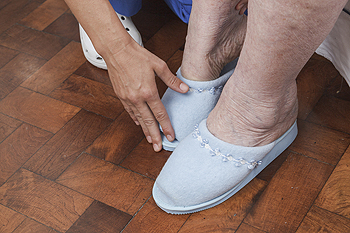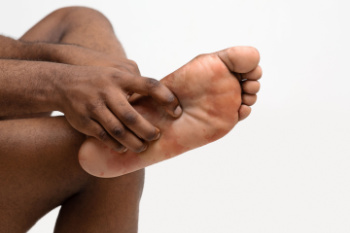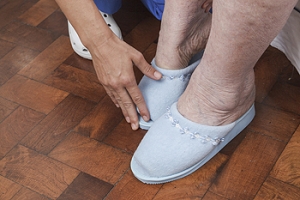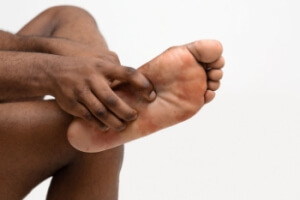
Back of the Ankle Pain Experienced by Dancers

Pain at the back of a dancer’s ankle can happen for various reasons, ranging from overuse to specific injuries. Achilles tendonitis, a common condition among dancers, results from repetitive stress on the Achilles tendon, leading to inflammation and discomfort. Another possible cause is posterior impingement syndrome, often seen in dancers who frequently point their toes, causing compression and irritation at the back of the ankle joint. Additionally, Haglund's deformity, characterized by a bony prominence at the back of the heel, can exacerbate discomfort, especially when wearing tight-fitting shoes. If you are a dancer and are experiencing ankle pain, it is suggested that you schedule an appointment with a podiatrist for an accurate diagnosis and effective treatment.
Ankle pain can be caused by a number of problems and may be potentially serious. If you have ankle pain, consult with Amir Shalev, DPM from Complete Foot & Ankle Care. Our doctor will assess your condition and provide you with quality foot and ankle treatment.
Ankle pain is any condition that causes pain in the ankle. Due to the fact that the ankle consists of tendons, muscles, bones, and ligaments, ankle pain can come from a number of different conditions.
Causes
The most common causes of ankle pain include:
- Types of arthritis (rheumatoid, osteoarthritis, and gout)
- Ankle sprains
- Broken ankles
- Achilles tendonitis
- Achilles tendon rupture
- Stress fractures
- Bursitis
- Tarsal tunnel syndrome
- Plantar fasciitis
Symptoms
Symptoms of ankle injury vary based upon the condition. Pain may include general pain and discomfort, swelling, aching, redness, bruising, burning or stabbing sensations, and/or loss of sensation.
Diagnosis
Due to the wide variety of potential causes of ankle pain, podiatrists will utilize a number of different methods to properly diagnose ankle pain. This can include asking for personal and family medical histories and of any recent injuries. Further diagnosis may include sensation tests, a physical examination, and potentially x-rays or other imaging tests.
Treatment
Just as the range of causes varies widely, so do treatments. Some more common treatments are rest, ice packs, keeping pressure off the foot, orthotics and braces, medication for inflammation and pain, and surgery.
If you have any questions, please feel free to contact our office located in Las Vegas, NV . We offer the newest diagnostic and treatment technologies for all your foot care needs.
Various Causes of Ankle Pain
Ankles are joints that connect bones in the feet with bones in the lower leg. They are comprised of bones, ligaments, muscles, tendons, blood vessels, and nerves. The ankle joint allows the foot to move side-to-side, as well as up-and-down.
Ankle pain can be caused by a variety of conditions, but is most commonly due to soft tissue injuries such as ankle sprains and strains.
An ankle sprain occurs when one or more of the strong ligaments that support and stabilize the ankle become overly stretched or even torn if the ankle rolls, turns, or twists awkwardly. Depending on the grade of sprain (mild-moderate-severe), there will be varying degrees of pain, swelling, and restricted range of motion, along with tenderness, bruising, and ankle instability. There may even be an audible popping noise at the moment of injury.
Ankle strains can sometimes produce similar symptoms of pain, swelling, and loss of motion, however, they are due to overly stretched muscles and tendons—not ligaments. Ankle strains may also cause muscle cramps in the feet, calves and shins.
Ankle fractures are another common source of ankle pain and occur one or more of the three bones in the ankle become fractured (broken). These breaks can be stress fractures (due to repetitive stress) or traumatic fractures (due to an acute injury). Depending on where and how severe the fracture is, symptoms can include pain and swelling that can sometimes spread up to the knee, bruising or discoloration, and an inability to bear weight. A visible deformity or exposed bone may occur in severe fractures.
Various forms of arthritis may also cause ankle pain. Rheumatoid arthritis (RA) causes the immune system to attack healthy joints, like the ankle joint, by mistake, causing stiffness and swelling in both ankles. Osteoarthritis occurs when cartilage covering the ends of bones wears down, causing the bones to rub against each other. This results in pain, stiffness, and reduced range of motion in the ankle. Gout is a form of arthritis where excess amounts of uric acid in the bloodstream crystallize and build up on joints, causing severe pain and swelling. Reactive arthritis causes joint pain and swelling in the ankle in response to an infection in another part of the body.
Other forms of ankle pain include bursitis (an inflammation of a cushioning bursa sac between tendons and bone), scleroderma (a thickening of connective tissues), chronic ankle instability (caused by improperly healed ankle sprains), Achilles tendon injuries, flat feet, or an infection in the ankle.
Education on Diabetic Foot Care

Educating diabetic patients about foot care is vital for preventing serious complications. Diabetes can lead to nerve damage and poor circulation in the feet, increasing the risk of infections and ulcers. Proper foot care practices, such as daily inspection, keeping feet clean and dry, trimming nails carefully, and wearing appropriate footwear, can help diabetic individuals avoid these issues. Additionally, understanding the importance of regular foot examinations by podiatrists can aid in early detection and treatment of any problems. Podiatrists play a vital role in assessing foot health, providing specialized care, and offering valuable guidance on preventive measures. If you have diabetes, it is strongly suggested that you schedule regular appointments with a podiatrist for examinations and important education that may help to prevent serious consequences of diabetes in the feet.
Diabetic foot care is important in preventing foot ailments such as ulcers. If you are suffering from diabetes or have any other concerns about your feet, contact Amir Shalev, DPM from Complete Foot & Ankle Care. Our doctor can provide the care you need to keep you pain-free and on your feet.
Diabetic Foot Care
Diabetes affects millions of people every year. The condition can damage blood vessels in many parts of the body, especially the feet. Because of this, taking care of your feet is essential if you have diabetes, and having a podiatrist help monitor your foot health is highly recommended.
The Importance of Caring for Your Feet
- Routinely inspect your feet for bruises or sores.
- Wear socks that fit your feet comfortably.
- Wear comfortable shoes that provide adequate support.
Patients with diabetes should have their doctor monitor their blood levels, as blood sugar levels play such a huge role in diabetic care. Monitoring these levels on a regular basis is highly advised.
It is always best to inform your healthcare professional of any concerns you may have regarding your feet, especially for diabetic patients. Early treatment and routine foot examinations are keys to maintaining proper health, especially because severe complications can arise if proper treatment is not applied.
If you have any questions please feel free to contact our office located in Las Vegas, NV . We offer the newest diagnostic and treatment technologies for all your foot and ankle needs.
Diabetic Foot Care
Diabetes can cause two problems that can potentially affect the feet: Diabetic neuropathy and Peripheral Vascular Disease. Diabetic neuropathy occurs when nerves in your legs and feet become damaged, which prevents you from feeling heat, cold, or pain. The problem with diabetic neuropathy is that a cut or sore on the foot may go unnoticed and the cut may eventually become infected. This condition is also a main cause of foot ulcers. Additionally, Peripheral vascular disease also affects blood flow in the body. Poor blood flow will cause sores and cuts to take longer to heal. Infections that don’t heal do to poor blood flow can potentially cause ulcers or gangrene.
There are certain foot problems that are more commonly found in people with diabetes such as Athlete’s foot, calluses, corns, blisters, bunions, foot ulcers, ingrown toenails, and plantar warts. These conditions can lead to infection and serious complications such as amputation. Fortunately, proper foot care can help prevent these foot problems before they progress into more serious complications.
Each day you should wash your feet in warm water with a mild soap. When you finish washing your feet, dry them carefully especially between your toes. You should also perform daily foot inspections to ensure you don’t have any redness, blisters, or calluses. Furthermore, if you are diabetic, you should always wear closed-toed shoes or slippers to protect your feet. Practicing these tips will help ensure that your feet are kept healthy and away from infection.
If you have diabetes, contact your podiatrist if you have any of the following symptoms on your feet: changes in skin color, corns or calluses, open sores that are slow to heal, unusual and persistent odor, or changes in skin temperature. Your podiatrist will do a thorough examination of your feet to help treat these problematic conditions.
What to Expect During Ingrown Toenail Surgery
 Ingrown toenail surgery, also known as partial nail avulsion, is a common procedure performed to treat ingrown toenails. It is often used for more severe cases of ingrown toenails, which do not respond to other conservative healing methods. During the surgery, the podiatrist administers local anesthesia to numb the toe, ensuring the patient's comfort throughout the procedure. Next, the podiatrist carefully removes a portion of the affected toenail, including the ingrown edge or spike that is causing pain and inflammation. This process may involve using surgical instruments or specialized tools to precisely trim the nail. For recurrent or severe cases, the podiatrist may also apply a chemical solution or use a laser to destroy the nail matrix, the area the nail grows from, to prevent the ingrown portion of the nail from regrowing. Then the toe is thoroughly cleaned. A sterile dressing may be applied to promote healing. The entire procedure typically takes less than an hour, and patients can usually resume normal activities shortly afterward. If you have an ingrown toenail, it is suggested that you consult a podiatrist who can offer correct treatment options, which may include surgery.
Ingrown toenail surgery, also known as partial nail avulsion, is a common procedure performed to treat ingrown toenails. It is often used for more severe cases of ingrown toenails, which do not respond to other conservative healing methods. During the surgery, the podiatrist administers local anesthesia to numb the toe, ensuring the patient's comfort throughout the procedure. Next, the podiatrist carefully removes a portion of the affected toenail, including the ingrown edge or spike that is causing pain and inflammation. This process may involve using surgical instruments or specialized tools to precisely trim the nail. For recurrent or severe cases, the podiatrist may also apply a chemical solution or use a laser to destroy the nail matrix, the area the nail grows from, to prevent the ingrown portion of the nail from regrowing. Then the toe is thoroughly cleaned. A sterile dressing may be applied to promote healing. The entire procedure typically takes less than an hour, and patients can usually resume normal activities shortly afterward. If you have an ingrown toenail, it is suggested that you consult a podiatrist who can offer correct treatment options, which may include surgery.
Foot surgery is sometimes necessary to treat a foot ailment. To learn more, contact Amir Shalev, DPM of Complete Foot & Ankle Care. Our doctor will assist you with all of your foot and ankle needs.
When Is Surgery Necessary?
Foot and ankle surgery is generally reserved for cases in which less invasive, conservative procedures have failed to alleviate the problem. Some of the cases in which surgery may be necessary include:
- Removing foot deformities like bunions and bone spurs
- Severe arthritis that has caused bone issues
- Cosmetic reconstruction
What Types of Surgery Are There?
The type of surgery you receive will depend on the nature of the problem you have. Some of the possible surgeries include:
- Bunionectomy for painful bunions
- Surgical fusion for realignment of bones
- Neuropathy decompression surgery to treat nerve damage
Benefits of Surgery
Although surgery is usually a last resort, it can provide more complete pain relief compared to non-surgical methods and may allow you to finally resume full activity.
Surgical techniques have also become increasingly sophisticated. Techniques like endoscopic surgery allow for smaller incisions and faster recovery times.
If you have any questions please feel free to contact our office located in Las Vegas, NV . We offer the newest diagnostic and treatment technologies for all your foot and ankle needs.
Foot and Ankle Surgery
When conservative, noninvasive methods prove ineffective, surgery may be selected as the next course of action for the treatment of your foot or ankle condition. A wide number of foot and ankle surgical procedures exist, and it is up to your podiatrist to determine which intervention will be most appropriate and helpful for your case. Some surgical procedures include bunion surgery, fusion, hammertoe surgery, heel spur surgery, metatarsal surgery, nail surgery, neuroma surgery, reconstructive surgery, skin surgery, and tendon surgery. Typically, surgery is turned to as a definitive way to alleviate excessive pain or discomfort and to return your foot to full mobility.
Regardless of the location on the body, all surgical procedures require preoperative testing and examination to ensure the surgery’s success and preferred outcome. A review of your medical history and medical conditions will take place, as will an evaluation of any current diseases, illnesses, allergies, and medications. Tests such as blood studies, urinalyses, EKG, X-rays, and blood flow studies may be ordered. Because the procedure involves the foot and/or ankle, the structures of your feet while walking may also be observed by your podiatrist.
Care post-surgery will depend on the type of surgical procedure performed. Typically, all postoperative care involves rest, ice, compression, and elevation. To improve and ensure a safe recovery, your foot and ankle surgeon may also employ the use of bandages, splints, surgical shoes, casts, crutches, or canes. He will also determine if and when you can bear weight. A timely and thorough recovery is a priority for both you and your podiatrist, and carefully following postoperative instructions can help achieve this.
Managing Chronic Foot Pain in the Elderly

Foot pain is prevalent among older individuals, affecting at least 25 percent of them. Unfortunately, the management of foot pain is often overlooked in geriatric healthcare, leading many seniors to endure chronic foot pain unnecessarily, which impacts their overall well-being. Research indicates that foot pain is a common and debilitating issue in older adults, but conservative interventions, including regular foot care, footwear guidance, and foot orthoses, have proven effective in reducing pain. These interventions not only alleviate foot discomfort but also contribute to maintaining mobility and independence in this age group. If you are in the elderly population and have foot pain, it is suggested that you schedule an appointment with a podiatrist for a proper diagnosis and treatment to help improve your quality of life.
Foot Pain
Foot pain can be extremely painful and debilitating. If you have a foot pain, consult with Amir Shalev, DPM from Complete Foot & Ankle Care. Our doctor will assess your condition and provide you with quality foot and ankle treatment.
Causes
Foot pain is a very broad condition that could be caused by one or more ailments. The most common include:
- Bunions
- Hammertoes
- Plantar Fasciitis
- Bone Spurs
- Corns
- Tarsal Tunnel Syndrome
- Ingrown Toenails
- Arthritis (such as Gout, Rheumatoid, and Osteoarthritis)
- Flat Feet
- Injury (from stress fractures, broken toe, foot, ankle, Achilles tendon ruptures, and sprains)
- And more
Diagnosis
To figure out the cause of foot pain, podiatrists utilize several different methods. This can range from simple visual inspections and sensation tests to X-rays and MRI scans. Prior medical history, family medical history, and any recent physical traumatic events will all be taken into consideration for a proper diagnosis.
Treatment
Treatment depends upon the cause of the foot pain. Whether it is resting, staying off the foot, or having surgery; podiatrists have a number of treatment options available for foot pain.
If you have any questions, please feel free to contact our office located in Las Vegas, NV . We offer the newest diagnostic and treatment technologies for all your foot care needs.
Foot Pain
The feet, being the foundation of the body, carry all of the body’s weight and are therefore prone to experiencing pain and discomfort. If you are experiencing foot pain, it is important to determine where in the foot you are experiencing this pain to help discover the cause of it. While pain can be experienced virtually anywhere in the foot, the most common sites of foot pain are in the heel and ankle.
Heel pain can be due to a multitude of conditions including plantar fasciitis, Achilles tendinitis, and heel spurs. Pain experienced in the ankle can be a sign of an ankle sprain, arthritis, gout, ankle instability, ankle fracture, or nerve compression. In more serious cases, pain in the foot can be a sign of improper alignment or an infection.
Foot pain can be accompanied by symptoms including redness, swelling, stiffness and warmth in the affected area. Whether the pain can be described as sharp or dull depends on the foot condition behind it. It is important to visit your local podiatrist if your foot pain and its accompanying symptoms persist and do not improve over time.
Depending on the location and condition of your foot pain, your podiatrist may prescribe certain treatments. These treatments can include but are not limited to prescription or over-the-counter drugs and medications, certain therapies, cortisone injections, or surgery.
If you are experiencing persistent foot pain, it is important to consult with your foot and ankle doctor to determine the cause and location. He or she will then prescribe the best treatment for you. While milder cases of foot pain may respond well to rest and at-home treatments, more serious cases may take some time to fully recover.
How Podiatrists Diagnose Plantar Fasciitis
 Diagnosing plantar fasciitis, an inflammatory condition in the foot which causes heel pain, involves an examination from a podiatrist. A podiatrist may first discuss medical history and symptoms with the patient. Then, this foot doctor will perform a physical examination of the feet, checking for signs such as tenderness in the heel and arch areas. They also check for flat feet, high arches, foot swelling, and tight Achilles tendons. The doctor may also order X-rays or ultrasounds to rule out other potential causes of heel pain. Additionally, during the examination, the podiatrist may assess the range of motion and gait for a comprehensive understanding of the foot mechanics. This combination of methods helps the podiatrist diagnose plantar fasciitis and tailor an effective treatment plan to alleviate pain and promote healing. For an accurate diagnosis and successful management of plantar fasciitis, it is suggested that you schedule an appointment with a podiatrist.
Diagnosing plantar fasciitis, an inflammatory condition in the foot which causes heel pain, involves an examination from a podiatrist. A podiatrist may first discuss medical history and symptoms with the patient. Then, this foot doctor will perform a physical examination of the feet, checking for signs such as tenderness in the heel and arch areas. They also check for flat feet, high arches, foot swelling, and tight Achilles tendons. The doctor may also order X-rays or ultrasounds to rule out other potential causes of heel pain. Additionally, during the examination, the podiatrist may assess the range of motion and gait for a comprehensive understanding of the foot mechanics. This combination of methods helps the podiatrist diagnose plantar fasciitis and tailor an effective treatment plan to alleviate pain and promote healing. For an accurate diagnosis and successful management of plantar fasciitis, it is suggested that you schedule an appointment with a podiatrist.
Plantar fasciitis is a common foot condition that is often caused by a strain injury. If you are experiencing heel pain or symptoms of plantar fasciitis, contact Amir Shalev, DPM from Complete Foot & Ankle Care. Our doctor can provide the care you need to keep you pain-free and on your feet.
What Is Plantar Fasciitis?
Plantar fasciitis is one of the most common causes of heel pain. The plantar fascia is a ligament that connects your heel to the front of your foot. When this ligament becomes inflamed, plantar fasciitis is the result. If you have plantar fasciitis you will have a stabbing pain that usually occurs with your first steps in the morning. As the day progresses and you walk around more, this pain will start to disappear, but it will return after long periods of standing or sitting.
What Causes Plantar Fasciitis?
- Excessive running
- Having high arches in your feet
- Other foot issues such as flat feet
- Pregnancy (due to the sudden weight gain)
- Being on your feet very often
There are some risk factors that may make you more likely to develop plantar fasciitis compared to others. The condition most commonly affects adults between the ages of 40 and 60. It also tends to affect people who are obese because the extra pounds result in extra stress being placed on the plantar fascia.
Prevention
- Take good care of your feet – Wear shoes that have good arch support and heel cushioning.
- Maintain a healthy weight
- If you are a runner, alternate running with other sports that won’t cause heel pain
There are a variety of treatment options available for plantar fasciitis along with the pain that accompanies it. Additionally, physical therapy is a very important component in the treatment process. It is important that you meet with your podiatrist to determine which treatment option is best for you.
If you have any questions, please feel free to contact our office located in Las Vegas, NV . We offer the newest diagnostic and treatment technologies for all your foot care needs.







